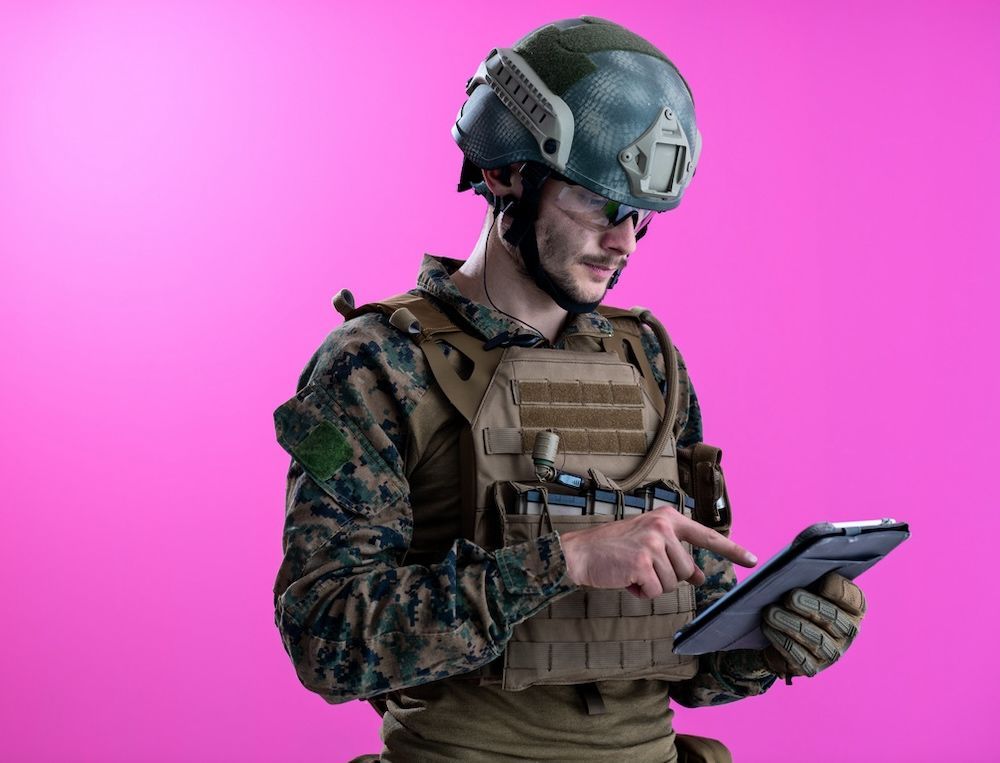Education Management Solutions for Military Mobile Simulation
Education Management Solutions (EMS) helps meet government and military medical simulation program needs with flexibility and efficiency. Recent downsizing and budgeting issues have led to challenges when attempting to train military healthcare reserve forces. EMS’ simulation solutions help manage clinical training programs to optimize skill development needed in the rapidly changing world with increased demands on governmental infrastructure. Military Mobile Simulation solutions are in higher demand, and help programs address the challenge to improve clinical outcomes with limited staff resources under budgetary constraints. This HealthySimulation.com article reviews the resources available for mobile military simulations provided by Education Management Solutions, including the new Training in Motion!
Knisely et al. state that combat medics are required to perform highly technical medical procedures in austere environments with minimal error. Effective means to quantify medic performance in field and simulated environments are critical to optimize medic training procedures as well as to evaluate the influence of medical equipment and other supportive technologies on medic performance. Human performance evaluation in combat casualty care presents many unique challenges due to the unique environment (battlefields) and population (medics) that must be represented. Recent advances in simulation and measurement technology have presented opportunities to improve simulation fidelity and measurement quality; however, researchers are unclear as to what extent these advances have been adopted in this domain.
Eubanks et al. state the concept of modeling and simulation (M&S) has long been an integral part of war-fighter military training, dating to before World War II when pilots and infantry soldiers would train with simulators and mockups to prepare for battle. Army and Navy aviators would practice flying in simulated cockpits. At the turn of this century, M&S saw application in healthcare. The most recent wars involving the United States and coalition partners have created the need for more training and practice in life-saving procedures on the battlefield and in the hospital. Therefore, simulation was accepted as a successful addition to the preparation of medical personnel.
Sponsored Content:
View the HealthySimulation.com LEARN CE/CME Platform to learn more!
New From Education Management Solutions: Training in Motion!
EMS’ groundbreaking new Training in Motion solution revolutionizes mobile and portable healthcare training through its flexible design and seamless integration capabilities. Training in Motion’s hardware-agnostic design effortlessly interfaces with all major vendor simulators, ensuring compatibility and allowing institutions to leverage their current investments in simulation technology. Furthermore, Training in Motion takes training to the next level through the integration with Apple Airplay and video conference software, enabling live streaming and the sharing of content across multiple locations.
With advanced video management and debriefing capabilities like bookmarking and annotation features, Training in Motion facilitates thorough post-training analysis and assessment. Additionally, multiple feed control empowers users to simultaneously display cameras, vitals, and simulator information, delivering comprehensive training experiences unique to on-the-go solutions. Currently, a maximum of 4 sources can be used. Examples are 3 cameras and 1 simulator, or 2 cameras, 1 vital signs, and 1 simulator. Training in Motion integrates seamlessly with a third-party video conferencing tool that can stream the simulation activity from a remote location to multiple classrooms, improving the cost-effectiveness and efficient use of trainers. This allows trainers the flexibility required to meet the needs in remote locations.
Sponsored Content:
By combining portability, seamless integration, live streaming, advanced video management, and multiple feed control, EMS’ Training in Motion solution sets a new standard for healthcare training, providing potential users with an unrivaled training solution that enhances skill development, knowledge retention, and overall training outcomes.
Training in Motion allows for easy video capture and management of the simulation from a remote location with bookmarks and a debrief facility. This allows for a portable and flexible training environment that can be easily transported to different locations, allowing for training to take place in a variety of settings, including in the field. This is particularly important for military medical personnel who may be required to provide medical care in remote or austere environments.
Mobile simulation solutions can be used repeatedly, allowing for a larger number of personnel to be trained and reducing the need for expensive equipment and supplies. Finally, mobile simulation solutions can be used to supplement traditional training methods and provide ongoing training and education for warfighters. This helps ensure personnel are up-to-date with the latest medical procedures and techniques and are prepared to handle a wide range of battlefield medical emergencies.
Training in Motion can provide a safe and controlled environment for trainees to practice their skills and gain experience handling medical emergencies. This is particularly important for military medical personnel who may be required to provide care in high-stress and high-pressure situations.
Among Veterans Administration hospitals and other government institutions, there is a mandate for improved clinical outcomes. The advanced technology behind EMS’ simulation management solutions delivers the tools you need to provide benchmarking and best practice insights to your learners. EMS simulation management solutions are GSA-listed to allow governmental end-users more efficiency in the acquisition of technology needed to manage clinical training programs.
Effectiveness of Mobile Simulation in the Military
Wiggins et al.A specific military unit collaborated with a university simulation center in order to provide more meaningful training experiences that mirrored the deployment operational experience. Training using simulation has been invaluable in improving team cohesiveness. Building a training curriculum has generated a new perspective on ways in which military units may train and assess the strengths and opportunities of the unit. The ability to see participants in action allowed for a clearer understanding of the knowledge and skill each participant actually possessed versus what was assumed. The information obtained was invaluable to leadership in determining the true readiness of the unit for deployment. The authors offer the scenarios, lesson plans, and curriculum that they developed to other units that are interested in the training.
Davis et al.Just-in-time learning is a concept increasingly applied to medical education, and its efficacy must be evaluated. Highly technical psychomotor procedures can be taught via mobile learning. A procedural animation video is an effective medium for teaching procedural skills. Embedding the video on a mobile device and allowing immediate access to trainees prior to performing skills, such as chest tube insertion, may enhance and standardize surgical education for civilians and military personnel.
Data Tracking and Management with EMS Solutions
EMS provides the only hardware and software-agnostic clinical simulation management operating platform that can deliver performance metrics for standardized patients and manikin-based simulation training to capture, organize, and analyze simulation training activities. EMS solutions endeavor to evaluate the quality of the learner’s performance, not the quantity of the simulation participation.
Matt Merino, CEO of Education Management Solutions, LLC, states, “The essential data our solutions harvest and automate provide critical insight to improve workflows, maximize training, and produce better outcomes. As a former service member, this mission is personal. EMS is honored to help pave the path to optimized critical care for our active-duty military personnel.”
https://www.youtube.com/watch?v=_GSqz9TCTMg
The Future of Military Healthcare Simulation
Eubanks et al. discussed that the future of simulation within the military healthcare system is bright. There are many areas in which the military is using simulation methodologies to enhance skills needed to care for service members in battle and themselves and their family members when hospitalized in military treatment facilities. Among the areas of active interest are:
AR/VR: The expanded use of augmented reality (AR) and virtual reality (VR) screen-based simulation to recreate environments of care is required. At the USUHS Simcenter, an immersive VR theater is being used to train teams of providers in multiple causality situations and aero-medical evacuation of patients. Head-mounted VR displays are being tested in Army field environments to see if this type of simulation method can help first responders recognize and treat life-threatening hemorrhage and airway emergencies.
Haptic Suits: Haptic devices and suits research is ongoing. New haptic suits can allow for more high-resolution haptic feedback. The feedback can be the pressure and vibrations that would occur in the real environment. This increases the immersion and realism of the users. In a study by Kang et al., a haptic suit can create distinguishable haptic patterns for guiding a task and improve the VR experience of users with powerful and multimodal haptic feedback. This study provides evidence that the incorporation of haptic suits can provide high-quality VR simulation.
Joint Medical Simulation Instructional Methods (JMedSIM): With the increasing emphasis on simulation, there is a pressing need to train more healthcare personnel to deliver healthcare simulation to learners. To that end, the MHS has launched JMedSIM, a standardized simulation instructor/operator online course that will allow simulation instructors to become familiar with effective training methods in healthcare simulation. The goal is for all those who employ simulation for training will be certified through this route.
Graduate education in simulation : There is a need for more advanced education and research in simulation methodology as the education and experience apply to operational military medicine. The USUHS has partnered with the Naval Postgraduate School in Monterey, California, to offer a jointly sponsored certificate program in healthcare simulation. These graduate-level courses have been taken by over 100 personnel in the last six years and are designed to educate the next generation of healthcare simulation professionals. A master’s level degree in healthcare simulation is now in the final stages of planning and execution.
Specific skills project: The MHS has recognized the need to tailor simulation to the individual skills of the physicians and nurses taking care of service members in deployed settings. The Department of Defense has developed specific knowledge, skill, and attribute (KSA) skillsets for each medical specialty. The KSA is essentially an annual tasklist and serves as a marker for how prepared a practitioner is for deployed medical operations. To augment the standard medical practice of the provider in the garrison and meet the KSA goals, simulation methods will be implemented where applicable.
More About Education Management Solutions (EMS)
Education Management Solutions merges essential information across environments, helping organizations align performance and capabilities between education, training, and active provider care. Seamlessly connecting and analyzing competency-based performance data for curriculum assessment and student performance tracking, EMS’ open architecture removes silos across OEM hardware, simulation training tools, video conferencing, and learning management systems. Fusing performance observations and measurements across immersive reality, hands-on education, and classroom instruction, EMS stays true to its core mission, integrated solutions, and elevated healthcare.
Learn More About EMS Training in Motion!
Teresa Gore, PhD, DNP, APRN, FNP-BC, CHSE-A, FSSH, FAAN – Dr. Gore has experience in educating future nurses in the undergraduate and graduate nursing programs. Dr. Gore has a PhD in Adult Education, a DNP as a family nurse practitioner, and a certificate in Simulation Education. Dr. Gore is an innovative, compassionate educator and an expert in the field of healthcare simulation. In 2007l Teresa started her journey in healthcare simulation. She is involved in INACSL and SSH. She is a Past-President of INACSL and is a Certified Healthcare Simulation Educator Advanced (CHSE-A). In 2018, she was inducted as a Fellow in the American Academy of Nursing (FAAN). In 2021, she was inducted as a Fellow in the Society of Simulation in Healthcare Academy (FSSH) and selected as a Visionary Leader University of Alabama at Birmingham School of Nursing Alumni. During her career, Dr. Gore has led in the development and integration of simulation into all undergraduate clinical courses and started an OSCE program for APRN students. Her research interests and scholarly work focus on simulation, online course development and faculty development. She has numerous invited presentations nationally and internationally on simulation topics.
Sponsored Content:


















